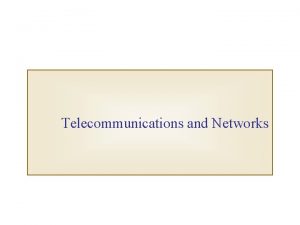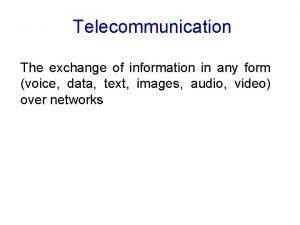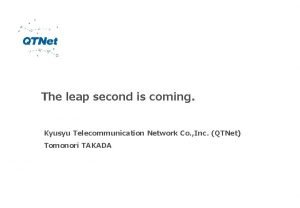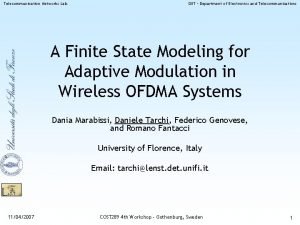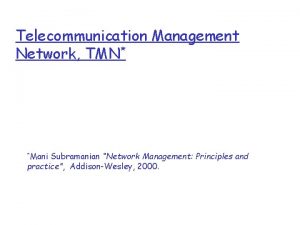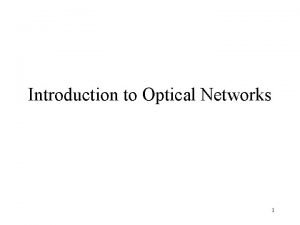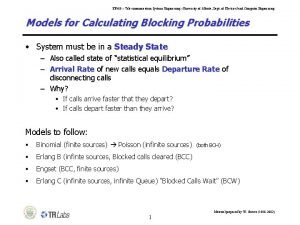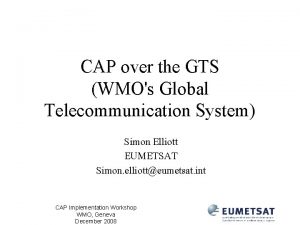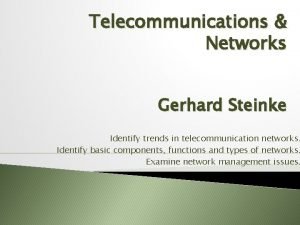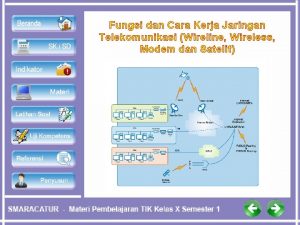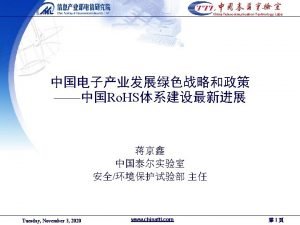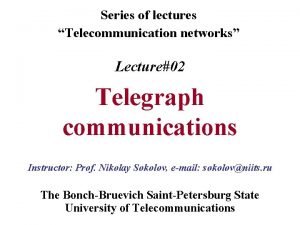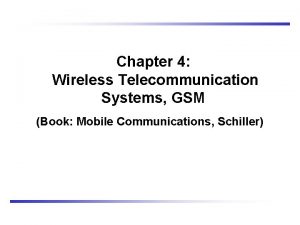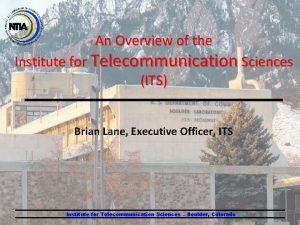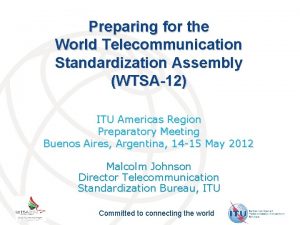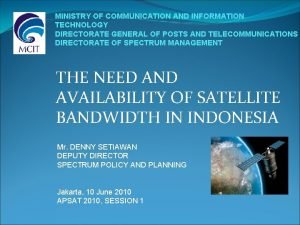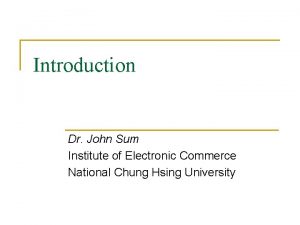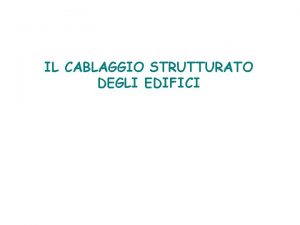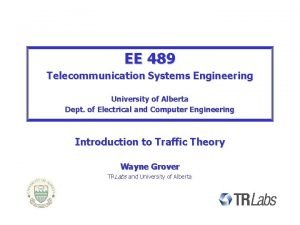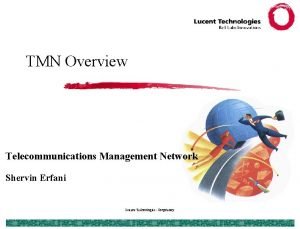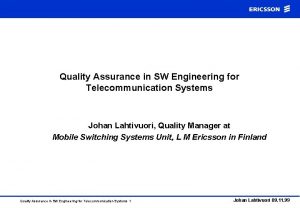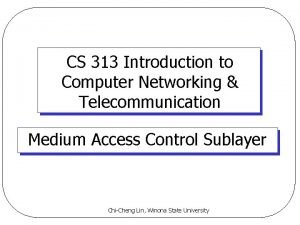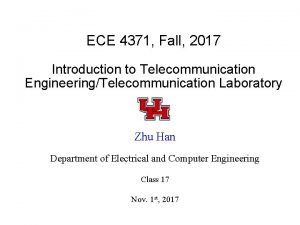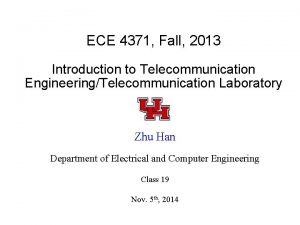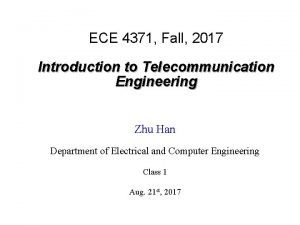ECE 4371 Fall 2017 Introduction to Telecommunication EngineeringTelecommunication












































- Slides: 44

ECE 4371, Fall, 2017 Introduction to Telecommunication Engineering/Telecommunication Laboratory Zhu Han Department of Electrical and Computer Engineering Class 11 Oct. 11 th, 2017

Outline l Eye Diagram l Partial Response l Carrier systems – – – ASK, OOK, MASK FSK, MFSK BPSK, DBPSK, MPSK MQAM, MQPR OQPSK, Continuous phase modulation (CPM): MSK, GMSK

Eye Diagram Setup l Eye diagram is a retrace display of data waveform – Data waveform is applied to input channel – Scope is triggered by data clock – Horizontal span is set to cover 2 -3 symbol intervals l Measurement of eye opening is performed to estimate BER – BER is reduced because of additive interference and noise – Sampling also impacted by jitter

Eye Diagram l Eye diagram is a means of evaluating the quality of a received “digital waveform” – By quality is meant the ability to correctly recover symbols and timing – The received signal could be examined at the input to a digital receiver or at some stage within the receiver before the decision stage l l l Eye diagrams reveal the impact of ISI and noise Two major issues are 1) sample value variation, and 2) jitter and sensitivity of sampling instant Eye diagram reveals issues of both Eye diagram can also give an estimate of achievable BER Check eye diagrams at the end of class for participation

Vertical and Horizontal Eye Openings l The vertical eye opening or noise margin is related to the SNR, and thus the BER – A large eye opening corresponds to a low BER The horizontal eye opening relates the jitter and the sensitivity of the sampling instant to jitter – The red brace indicates the range of sample instants with good eye opening – At other sample instants, the eye opening is greatly reduced, as governed by the indicated slope l

Interpretation of Eye Diagram

Cosine rolloff filter: Eye pattern 2 nd Nyquist 1 st Nyquist: 2 nd Nyquist: 1 st Nyquist 1 st Nyquist: 2 nd Nyquist: 1 st Nyquist:

Eye Diagram l The eye diagram is created by taking the time domain signal and overlapping the traces for a certain number of symbols. l The open part of the signal represents the time that we can safely sample the signal with fidelity

Figure 4. 34 (a) Eye diagram for noiseless quaternary system. (b) Eye diagram for quaternary system with SNR 20 d. B. (c) Eye diagram for quaternary system with SNR 10 d. B.

Figure 4. 35 (a) Eye diagram for noiseless band-limited quaternary system: cutoff frequency fo 0. 975 Hz. (b) Eye diagram for noiseless band-limited quaternary system: cutoff frequency fo 0. 5 Hz.

Jitter in Circuit design l Circuit design

Eye Diagram In Phase

Linear Modulation with Nyquist Impulse Shaping QPSK diagram under limited bandwidth conditions if system (tx and rx filter) meets 1 st Nyquist : 4 sharp signal points (right diagram)

Partial Response Signals l Previous classes: Sy(w)=|P(w)|^2 Sx(w) – Control signal generation methods to reduce Sx(w) – Raise Cosine function for better |P(w)|^2 l This class: improve the bandwidth efficiency – Widen the pulse, the smaller the bandwidth. – But there is ISI. For binary case with two symbols, there is only few possible interference patterns. – By adding ISI in a controlled manner, it is possible to achieve a signaling rate equal to the Nyquist rate (2 W symbols/sec) in a channel of bandwidth W Hertz.

Example l Duobinary Pulse – p(n. Tb)=1, n=0, 1 – p(n. Tb)=1, otherwise l Interpretation of received signal – 2: 11 – -2: 00 – 0: 01 or 10 depends on the previous transmission

Duobinary signaling l Duobinary signaling (class I partial response)

Duobinary signal and Nyguist Criteria l Nyguist second criteria: but twice the bandwidth

Differential Coding l The response of a pulse is spread over more than one signaling interval. l The response is partial in any signaling interval. l Detection : – Major drawback : error propagation. l To avoid error propagation, need deferential coding (precoding).

Modified duobinary signaling l Modified duobinary signaling – In duobinary signaling, H(f) is nonzero at the origin. – We can correct this deficiency by using the class IV partial response.

Modified duobinary signaling l Spectrum

Modified duobinary signaling l Time Sequency: interpretation of receiving 2, 0, and -2?

Pulse Generation l Generalized form of correlative-level coding (partial response signaling)

Tradeoffs l Binary data transmission over a physical baseband channel can be accomplished at a rate close to the Nyquist rate, using realizable filters with gradual cutoff characteristics. l Different spectral shapes can be produced, appropriate for the application at hand. l However, these desirable characteristics are achieved at a price : – A large SNR is required to yield the same average probability of symbol error in the presence of noise.

Other types of partial response signals paper Type r 0 r 1 r 2 r 3 r 4 ideal 1 I 1 1 II 1 2 1 5 III 2 1 -1 6 IV 1 0 -1 3 V -1 0 2 p(t) P(W) Levels 2 3 0 -1 5

ASK, OOK, MASK l The amplitude (or height) of the sine wave varies to transmit the ones and zeros l One amplitude encodes a 0 while another amplitude encodes a 1 (a form of amplitude modulation)

Binary amplitude shift keying, Bandwidth l d ≥ 0 related to the condition of the line B = (1+d) x S = (1+d) x N x 1/r

Implementation of binary ASK

OOK and MASK l OOK (On-OFF Key) – 0 silence. – Sensor networks: battery life, simplementation l MASK: multiple amplitude levels

Pro, Con and Applications l Pro – Simplementation l Con – Major disadvantage is that telephone lines are very susceptible to variations in transmission quality that can affect amplitude – Susceptible to sudden gain changes – Inefficient modulation technique for data l Applications – – On voice-grade lines, used up to 1200 bps Used to transmit digital data over optical fiber Morse code Laser transmitters

Frequency Shift Keying l One frequency encodes a 0 while another frequency encodes a 1 (a form of frequency modulation) l Represent each logical value with another frequency (like FM)

FSK Bandwidth l l Limiting factor: Physical capabilities of the carrier Not susceptible to noise as much as ASK l Applications – On voice-grade lines, used up to 1200 bps – Used for high-frequency (3 to 30 MHz) radio transmission – used at higher frequencies on LANs that use coaxial cable

Multiple Frequency-Shift Keying (MFSK) l More than two frequencies are used l More bandwidth efficient but more susceptible to error f i = f c + (2 i – 1 – M)f d u f c = the carrier frequency u f d = the difference frequency L u M = number of different signal elements = 2 u L = number of bits per signal element u

Phase Shift Keying l One phase change encodes a 0 while another phase change encodes a 1 (a form of phase modulation)

DBPSK, QPSK l Differential BPSK – 0 = same phase as last signal element – 1 = 180º shift from last signal element l Four Level: QPSK

QPSK Example

Bandwidth l Min. BW requirement: same as ASK! l Self clocking (most cases)

Concept of a constellation diagram

MPSK l Using multiple phase angles with each angle having more than one amplitude, multiple signals elements can be achieved – – D = modulation rate, baud R = data rate, bps M = number of different signal elements = 2 L L = number of bits per signal element

QAM – Quadrature Amplitude Modulation l Modulation technique used in the cable/video networking world l Instead of a single signal change representing only 1 bps – multiple bits can be represented buy a single signal change l Combination of phase shifting and amplitude shifting (8 phases, 2 amplitudes)

QAM – As an example of QAM, 12 different phases are combined with two different amplitudes – Since only 4 phase angles have 2 different amplitudes, there a total of 16 combinations – With 16 signal combinations, each baud equals 4 bits of information (2 ^ 4 = 16) – Combine ASK and PSK such that each signal corresponds to multiple bits – More phases than amplitudes – Minimum bandwidth requirement same as ASK or PSK l

QAM and QPR l QAM is a combination of ASK and PSK – Two different signals sent simultaneously on the same carrier frequency – M=4, 16, 32, 64, 128, 256 l Quadrature Partial Response (QPR) – 3 levels (+1, 0, -1), so 9 QPR, 49 QPR

Offset quadrature phase-shift keying (OQPSK) l QPSK can have 180 degree jump, amplitude fluctuation l By offsetting the timing of the odd and even bits by one bit-period, or half a symbol-period, the in-phase and quadrature components will never change at the same time.

Continuous phase modulation (CPM) l CPM the carrier phase is modulated in a continuous manner l constant-envelope waveform l yields excellent power efficiency l high implementation complexity required for an optimal receiver l minimum shift keying (MSK) – Similarly to OQPSK, MSK is encoded with bits alternating between quarternary components, with the Q component delayed by half a bit period. However, instead of square pulses as OQPSK uses, MSK encodes each bit as a half sinusoid. This results in a constant-modulus signal, which reduces problems caused by non-linear distortion. ECE 4371 Fall 2008

Gaussian minimum shift keying l GMSK is similar to MSK except it incorporates a premodulation Gaussian LPF l Achieves smooth phase transitions between signal states which can significantly reduce bandwidth requirements l There are no well-defined phase transitions to detect for bit synchronization at the receiving end. l With smoother phase transitions, there is an increased chance in intersymbol interference which increases the complexity of the receiver. l Used extensively in 2 nd generation digital cellular and cordless telephone apps. such as GSM
 Telecommunication processors
Telecommunication processors Njdv
Njdv Risk management in telecommunication projects
Risk management in telecommunication projects Objectives of telecommunication
Objectives of telecommunication Telecommunication information
Telecommunication information Means communication at a distance
Means communication at a distance Kyushu telecommunication network co.,inc.
Kyushu telecommunication network co.,inc. Telecommunication
Telecommunication Telecommunication network management
Telecommunication network management Swift finance retrievals
Swift finance retrievals Telecommunication network architecture
Telecommunication network architecture Telecommunication
Telecommunication Global telecommunication system
Global telecommunication system Telecommunication trends
Telecommunication trends Global telecommunication system
Global telecommunication system Itu world telecommunication indicators database
Itu world telecommunication indicators database Apa itu jaringan wireline
Apa itu jaringan wireline China telecommunication technology labs
China telecommunication technology labs Telecommunication
Telecommunication Telecommunication sealing technology
Telecommunication sealing technology Bsc and msc in telecom
Bsc and msc in telecom Institute for telecommunication sciences
Institute for telecommunication sciences World telecommunication standardization assembly
World telecommunication standardization assembly Ministry of telecommunication
Ministry of telecommunication Rrpdata
Rrpdata Telecommunication
Telecommunication Cablaggio strutturato edifici
Cablaggio strutturato edifici University of alberta
University of alberta Shervin erfani
Shervin erfani Umos msu
Umos msu Telecommunication system architecture with diagram
Telecommunication system architecture with diagram Quality control in telecommunication
Quality control in telecommunication Telecommunication sealing technology
Telecommunication sealing technology Telecommunications for dummies
Telecommunications for dummies Telecommunication medium
Telecommunication medium China telecommunication technology labs
China telecommunication technology labs Network management principles and practice
Network management principles and practice Telecommunication system architecture with diagram
Telecommunication system architecture with diagram Body paragraph
Body paragraph Vce study score bell curve
Vce study score bell curve Mon tue wed thur fri sat sun
Mon tue wed thur fri sat sun Saasta astro quiz 2017 round 1 answers
Saasta astro quiz 2017 round 1 answers Astro quiz round 2
Astro quiz round 2 Saasta astro quiz 2017 round 2 questions and answers
Saasta astro quiz 2017 round 2 questions and answers Forrester wave identity governance
Forrester wave identity governance



